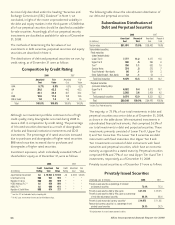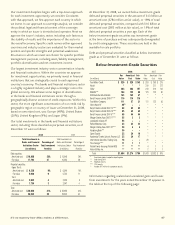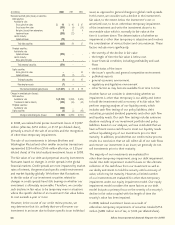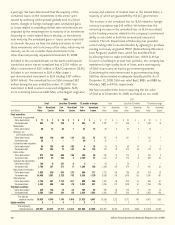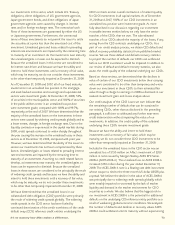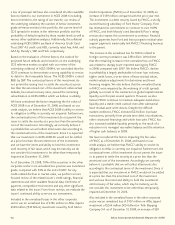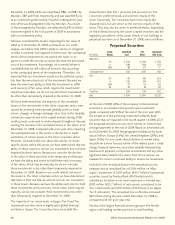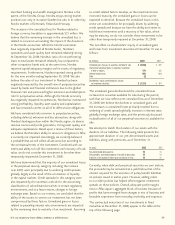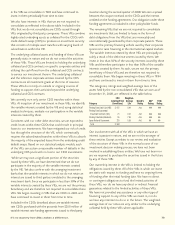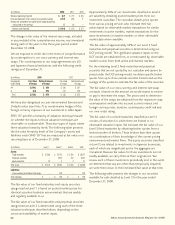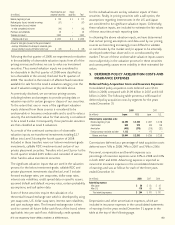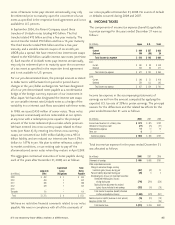Aflac 2008 Annual Report Download - page 79
Download and view the complete annual report
Please find page 79 of the 2008 Aflac annual report below. You can navigate through the pages in the report by either clicking on the pages listed below, or by using the keyword search tool below to find specific information within the annual report.
75
It’s no mystery how Aflac makes a difference.
million as compared with the prior year end. This investment
is a loan to Tollo Shipping Company S.A., guaranteed by the
borrower’s parent, Compania Sudamericana de Vapores
S.A. (CSAV). As of December 31, 2008, CSAV was the
largest shipping company in Latin America, and the 16th
largest shipping company in the world. CSAV provides liner
and specialized cargo services to clients worldwide with an
emphasis on container shipping to and from its key markets
of Chile and Brazil. Strong ties with Chile’s top exporters and
a well-developed logistics service are CSAV’s main competitive
advantages compared with other shippers with greater capacity.
The increase in the unrealized loss for CSAV related to foreign
currency translation was $22 million. We believe that the
remaining decline in fair value of the security was primarily
caused by two factors: depressed revenue due to competitive
pricing pressures in the container shipping industry and
weaker operating margins due to sharply increased fuel costs.
However, CSAV continues to maintain sound liquidity, with
adequate cash and cash equivalents reserves a benign debt
maturity profile, and a substantial undrawn credit facility. In
addition, CSAV is now in the process of raising additional
share capital over the next 12 to 24 months, which will further
strengthen its financial profile.
We have considered the factors impacting the fair value
of CSAV as of December 31, 2008, and based on our
credit analysis, we believe that CSAV’s ability to service its
obligation to Aflac is currently not impaired. Furthermore, the
contractual terms of this investment do not permit the issuer
or its parent to settle the security at a price less than the
amortized cost of the investment. Accordingly, we currently
believe it is probable that we will collect all amounts due
according to the contractual terms of the investment. Since it
is expected that our investment in CSAV would not be settled
at a price less than the amortized cost of the investment
and we have the intent and ability to hold this investment
until recovery of fair value, which may be maturity, we do
not consider this investment to be other-than-temporarily
impaired at December 31, 2008.
An additional amount included in the unrealized losses in
the other corporate sector was an unrealized loss of $124
million on Aflac Japan’s $384 million (¥35 billion) investment
issued by Sultanate of Oman (Oman) as of December 31,
2008, an increase of $94 million as compared with the
prior year end. This investment is a debt security issued by
Oman, a sovereign nation bordering the Arabian Sea, Gulf of
Oman and Persian Gulf with significant natural resources in
petroleum and natural gas, copper, asbestos, as well as some
marble, limestone, chromium and gypsum. Oman is noted for
its strong public finances, including modest indebtedness and
substantial financial assets and foreign exchange reserves.
The increase in the unrealized loss on this debt security
related to foreign currency translation was $25 million. We
believe that the remaining decline in the fair value of Oman
was caused principally by two factors. First, a worsening
in fiscal measures due to worldwide declines in oil prices
and sustained social and infrastructure expenditures of the
sovereign nation of the Sultanate of Oman. Second, Oman
is exposed to somewhat elevated regional political risks, such
as the ongoing conflicts in the Middle East and continued
political tensions. Despite its economic pressures, Oman has
maintained sound financial assets, substantial oil and natural
gas reserves, strong and growing gross domestic production
per capita, domestic political stability and strong international
relations. Throughout 2008, Oman’s credit rating remained at
A and A2 by S&P and Moody’s, respectively.
We have considered the factors impacting the fair value of
Oman as of December 31, 2008, and based on our credit
analysis, we believe that Oman’s ability to service its obligation
to Aflac is currently not impaired. Furthermore, the contractual
terms of this investment do not permit the issuer or its parent
to settle the security at a price less than the amortized cost of
the investment. Accordingly, we currently believe it is probable
that we will collect all amounts due according to the contractual
terms of the investment. Since it is expected that our
investment in Oman would not be settled at a price less than
the amortized cost of the investment and we have the intent
and ability to hold this investment until recovery of fair value,
which may be maturity, we do not consider this investment to
be other-than-temporarily impaired at December 31, 2008.
Another amount included in the unrealized losses in other
corporate sector was an unrealized loss of $117 million on Aflac
Japan’s investment of $339 million (¥30.8 billion) in UPM-
Kymmene Corporation (UPM), one of the world’s largest forest
product companies. The unrealized loss on UPM increased $108
million during the year ended December 31, 2008. The increase
in the unrealized loss for UPM related to foreign currency
translation was $24 million. The remaining decline in value in
UPM was due to the currently poor fundamental profile of
the forest products sector as a whole. UPM and its peers have
been negatively impacted by both weakening demand due to
poor economic conditions and the significant excess capacity
present in the sector. While UPM has been a leader among its
peers in capacity reductions, the sector needs significantly more
reductions in capacity so as to improve producer pricing power.
Despite the negative outlook for the forest product sector,
UPM possesses an above average competitive profile
compared with its forest product peers. Through its successful
efforts to control costs, improve its position in energy self-
sufficiency, and diversify its products, UPM has maintained
solid operating ratios, earnings profitability and liquidity. As of



